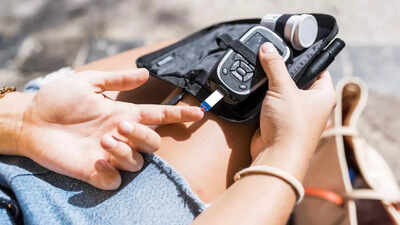ARTICLE AD BOX

Imagine falling prey to one of the most concerning diseases of all time and not even being aware of it, let alone being prepared to take measures to manage it.That’s what’s happening with diabetic patients. Nearly half of all people living with diabetes don’t even know it!An eye-opening new study reveals that a staggering 44% of individuals aged 15 and older worldwide, especially in younger adults and in lower-income regions where screenings are scarce, remain undiagnosed despite suffering from diabetes.
Without symptoms or testing, this “invisible” condition quietly damages hearts, kidneys, eyes, and nerves.Yet, early detection can be a lifesaver. By knowing the subtle signs, like constant thirst, frequent trips to the loo, or blurred eyesight, you might catch diabetes before it causes serious damage.
What do the numbers say
Numbers don’t lie – the alarming numbers that have come to light, thanks to a recent study, are evidence that there’s a huge gap in global statistics of undiagnosed diabetes. A landmark study published in The Lancet Diabetes & Endocrinology, led by the Institute for Health Metrics and Evaluation (IHME), found that 44% of people aged 15 and older with diabetes are unaware of their condition. That means nearly one in every two people with diabetes is not being treated, posing a huge risk globally.Young adults are especially at risk for going undiagnosed, although diabetes in them can lead to long-term, serious complications.
Once diagnosed, 91% of individuals are receiving medication, but only 42% manage their blood sugar well, meaning just about 21% of all people with diabetes globally have it under control – which, needless to say, is worrisome.

This “silent epidemic” is growing, especially dangerous as the number of global diabetes cases is projected to reach 1.3 billion by 2050.This silent crisis is most severe in low- and middle-income countries, where access to testing and healthcare is limited.
In these regions, diagnosis rates can be as low as under 20%, compared to much higher awareness in high-income areas such as North America.
Why it matters
Let’s start by understanding what diabetes is and then calculating the cost of the missed diagnosis of the same.What is diabetes?Diabetes is a chronic condition where the body has persistently high blood glucose (sugar) levels because it either doesn't produce enough insulin or cannot effectively use the insulin it produces.
Insulin is a hormone that helps glucose, the body's main source of energy, enter cells. Without proper insulin function, glucose stays in the blood, leading to serious long-term damage to the eyes, nerves, kidneys, and heart.
The most common types are Type 1, Type 2, and gestational diabetes.Types of diabetesType 1 diabetes: The immune system attacks and destroys the insulin-producing cells in the pancreas, so the body makes little to no insulin. Type 2 diabetes: The most common form of diabetes, where the body either doesn't produce enough insulin or becomes resistant to the insulin it does make. Gestational diabetes: A temporary form that occurs during pregnancy due to hormonal changes, leading to insulin resistance.

Now, diabetes is dangerous when left untreated. It raises risks of heart disease, strokes, kidney failure, vision loss, nerve damage, and even early death.
What’s more tragic is that, without knowing they have diabetes, many miss the chance to manage it early, causing damage before they even get diagnosed.Here’s why it’s more harmful than usual, if left untreatedHidden damage: Unchecked high blood sugar quietly harms vital organs, heart, kidneys, eyes, nerves, often before symptoms appear.More difficult to reverse: The longer diabetes goes unmanaged, the harder it becomes to control blood sugar and avoid complications.Better outcomes with treatment: Early detection enables timely lifestyle and medication interventions that reduce risks and preserve quality of life.
Early warning signs: What to look out for
Diabetes has yet to have a proper cure; hence, as of now, this disease can only be managed with certain lifestyle adjustments and medications. However, catching diabetes early can make a huge difference to one’s quality of life.Here are some early, often subtle symptoms:Frequent urination and excessive thirst: High blood sugar pulls fluid from tissues, leaving you thirsty and causing more bathroom trips.
You should take note and notice if that’s become a pattern. If yes, then consult a professional healthcare provider for tests.Sense of fatigue: Without enough sugar entering cells, energy drops and fatigue sets in, often dismissed as exhaustion from work, stress, or just simple tiredness.Blurred vision: High blood sugar can cause fluid changes in the eye lenses, affecting focus.Slow-healing wounds, especially on feet: High sugar levels impair your ability to heal and fight infection.Unexpected weight loss: This can occur particularly in type 1 diabetes, but type 2 can cause this too if left unchecked.Increased hunger or tingling in the feet: These are signs of nerve irritation or glucose fluctuations, which can indicate some underlying health issues, often leading to the diagnosis of diabetes.These signs can be quiet whispers – often ignored, and blamed on aging or busy lives. Yet they can be lifesaving alarms when followed by a simple blood test.
What you should do
If you notice any of the above symptoms or belong to a risk group, like being overweight, over age 40, having a family history of diabetes, or being from a high-risk ethnic background, don’t wait. Ask your doctor about:Fasting plasma glucose testOral glucose tolerance testHbA1c or A1C test, which measures your average blood sugar over the past 2-3 months.Early diagnosis enables early action: lifestyle changes, medication, and regular monitoring to avoid long-term harm.Additionally, embrace smart lifestyle steps, like a balanced diet, regular activity, and maintaining a healthy weight, even without diabetes. These simple lifestyle hacks help you lead a healthier life, nevertheless.
Retinas: New potential clues in diagnosing, treating Alzheimer's



.png)
.png)
.png)
















 3 hours ago
4
3 hours ago
4







 English (US) ·
English (US) ·